Funerary and memory sites of the First World War (Western Front): The Western Front was a 750 km line of fortified trenches and fortifications that stretched from the northern border between Belgium and the Netherlands (who remaind neutral in the First World War) to the northern border between France and Switzerland. The Western Front was the most important battleground of the First World War (1914-1918). The Western Front was the battleground between the Allies (initially France, the British Empire, Japan and Russia, later also Italy and the U.S.A.) and the Central Powers (primarily Germany, Austria-Hungary, the Ottoman Empire and Bulgaria). Ieper (Ypres) in Belgium and Verdun in France are the most important and well known locations on the Western Front. The funerary and memory sites of the First World War (Western Front) were inscribed on the UNESCO World Heritage List in 2023. The UNESCO World Heritage Site is composed of 139 locations in Belgium and France, 27 of these locations are situated in Flanders Fields, Belgium.
www.werelderfgoedfotos.nl © Copyright World Heritage Photos
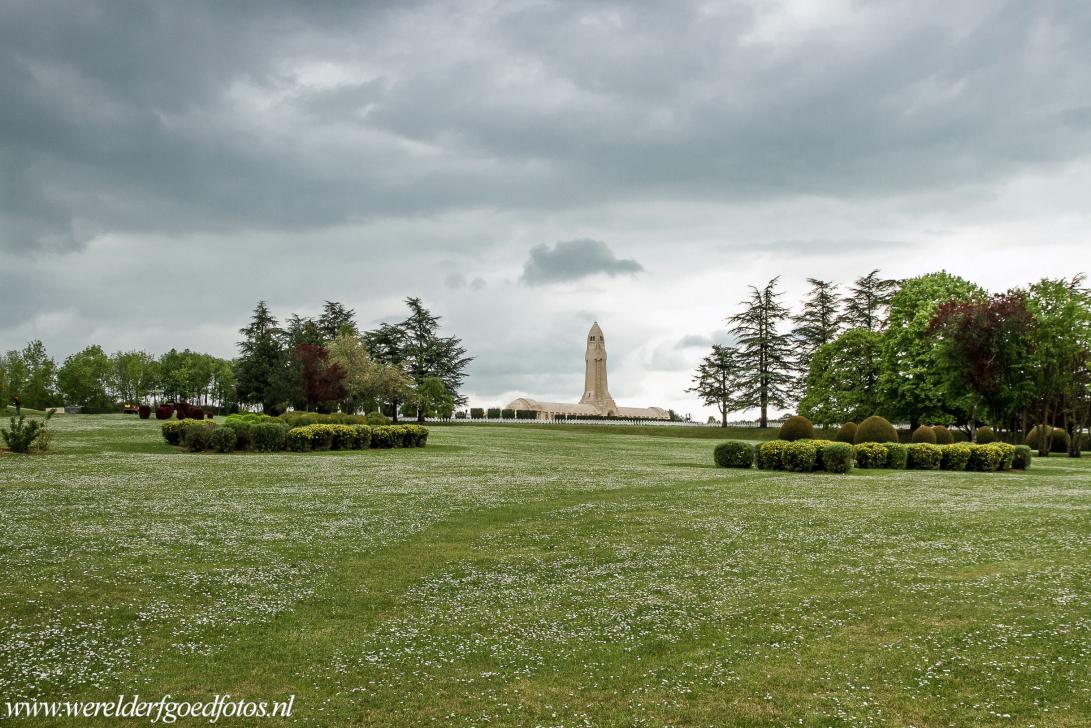
Funerary and memory sites of the First World War (Western Front): The Douaumont Ossuary is located within the former battlefields of Verdun. After the end of the Frist World War, thousands of bodies were discovered on the battlefields of Verdun. Charles Ginisty, the Bishop of Verdun, decided to gather the bones of the unidentified soldiers in a place of remembrance. The first stone of the Douaumont Ossuary was laid by the French General Philippe Pétain in 1920. The Douaumont Ossuary was officially inaugurated in 1932.

Funerary and memory sites of the First World War (Western Front): The Douaumont Ossuary is located within the former battlefields of Verdun. After the end of the Frist World War, thousands of bodies were discovered on the battlefields of Verdun. Charles Ginisty, the Bishop of Verdun, decided to gather the bones of the unidentified soldiers in a place of remembrance. The first stone of the Douaumont Ossuary was laid by the French General Philippe Pétain in 1920. The Douaumont Ossuary was officially inaugurated in 1932.
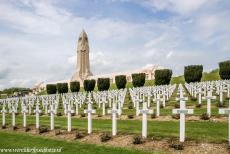
Funerary and memory sites of the First World War (Western Front): The Douaumont Ossuary is located a few kilometres from Verdun. The Ossuary and the Necropilis/Cemetery are located on the grounds where the Battle of Verdun took place. The battle was fought from 21 Febrary to 18 December 1916. The Battle of Verdun lasted 302 days and was the longest and bloodiest battle in modern history, and the plan of the German general von Falkenhayn to destroy the French Army had failed. The French suffered 377,231 casualties, the Germans 337,000.
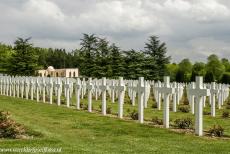
Funerary and memory sites of the First World War (Western Front): The Memorial to the Muslim soldiers of Verdun was inaugurated in 2006, it is dedicated to the 30,000 Muslim soldiers who fell during the Battle of Verdun. The Moorish style monument is located on the east side of the cemetery in front of the Douaumont Ossuary, on the other side of the cemetery is a memorial dedicated to the foreign volunteers and French Jews who fell for France during the First World War, also known as the Great War.
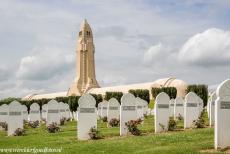
Funerary and memory sites of the First World War (Western Front): Douaumont Ossuary and cemetery. More than 16,000 identified French soldiers were buried in the cemetery in front of the ossuary. The cemetery is also the final resting place of 592 Muslim soldiers who were killed during the Battle of Verdun, their graves in the Muslim section are facing Mecca. The Muslim soldiers played a crucial role during the Battle of Verdun. The muslim soldiers were volunteers from the former French colonies.
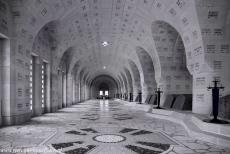
Funerary and memory sites of the First World War (Western Front): Inside the Douaumont Ossuary, the names of around 4,000 soldiers who were killed during the Battle of Verdun are engraved on the walls and vaults of this imposing monument. The Douaumont Ossuary houses 46 granite tombs, one for each main sector of the battlefield, containing the skeletal remains of more than 130,000 unknown French and German soldiers. More than 16,000 identified French soldiers were buried in the cemetery in front of the ossuary.
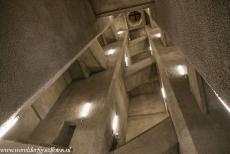
Funerary and memory sites of the First World War (Western Front): The inside of the 46 metres high tower of the Douaumont Ossuary. The tower is known as the Lantern of the Dead. The tower offers a dramatic view over the former battlefields of Verdun and the cemetery with the endless rows of white crosses on the graves of the fallen soldiers. At night, the beacon in the tower lights the battlefield with its white and red lights, the lights can be seen from miles away. the tower also contains a bronze death-bell, weighing over twe tonnes, the Bourdon de Victoire.
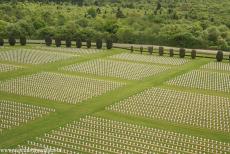
Funerary and memory sites of the First World War (Western Front): A section of the Douaumont Cemetery and the former battlefieds of Verdun viewed from atop the tower of the Douaumont Ossuary. The crosses are facing the former battlefields of Verdun. The Douaumont Cemetery is known as the National Cemetery of Fleury-devant-Douaumont. The cemetery was created in 1923. The bodies of 80,000 soldiers were never recovered from the battlefields of Verdun. They still lie buried in the soil of battlefields of Verdun.
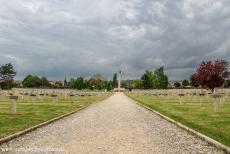
Funerary and memory sites of the First World War (Western Front): The French War Cemetery Faubourg Pavé in Verdun contains 600 French war graves from the Second World War and 4,906 war graves from the First World War. The cemetery is also the last resting place of seven British soldiers, one Belgian and one Polish soldier who were killed in the Second World War, and also a grave of a resistance fighter and a grave of an unknown victim of the Second World War. Near the side entrance are the graves of seven airmen who fought and died in the Second World War.
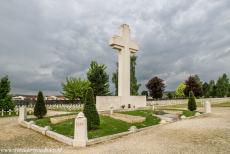
Funerary and memory sites of the First World War (Western Front): In the middle of the French War Cemetery Faubourg Pavé are the graves of seven unknown soldiers. After the First World War, a ceremony was held in the underground citadel of Verdun to choose the Unkown Soldier. The Unkown Soldier buried beneath the Arc the Triompfe in Paris since 1920 was chosen out of the remains of eight unkown soldiers. The other seven unknown soldiers were buried in the War Cemetery Faubourg Pavé, located in Verdun.
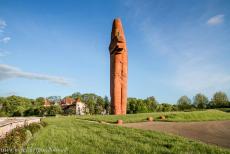
Funerary and memory sites of the First World War (Western Front): The National Monument of the Marne Victory at Mondement. The First Battle of the Marne took place from five to nine September 1914 and is considered one of the most decisive battles of the First World War. Many soldiers lost their lives. The 33 metres high monument was constructed between 1932 and 1939 in memory of the Allied Victory of the First Battle of the Marne and dedicated to the Zouaves of the Moroccan Division and the 77th Infantry Regiment of Cholet.
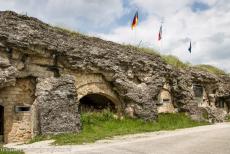
Funerary and memory sites of the First World War (Western Front): Fort Douaumont. After the Franco-German War (1870-1871), the medieval ring of fortifications of Verdun were completely modernised. In 1914, Verdun was the most fortified city in France, the powerful defense system of Verdun consisted of two rings of armed forts, casemates and shelters surrounding the city and its underground citadel. Fort Douaumont was the largest fort on the ring. Fort Douaumont was built between 1885 and 1913, it was the most powerful fort of its kind.
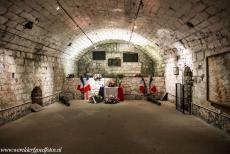
Funerary and memory sites of the First World War (Western Front): Fort Douaumont was conquered by the Germans on 25 February 1916, four days after the beginning of the Battle of Verdun. The German troops occupied the fort for eight months and used it as a shelter and a major base for their offensives. The French Army tried to recapture the fort for eight months. On 24 Octobre 1916, the French Colonial troops, a Moroccan infantry regiment and Senegalese tirailleurs, finally succeeded to recapture the fort.
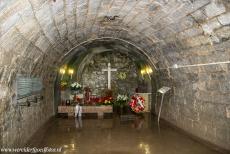
Funerary and memory sites of the First World War (Western Front): An underground casemate inside Fort Douaumont is the final resting place of 679 German soldiers who were killed by a massive explosion followed by a devastating fire on 8 May 1916. At the time, their remains were gathered inside the fort and placed into the casemate which was closed off with a wall. There is a white cross on the wall with the German text 'Den Toten Kameraden' (To the dead comrades). The casemate is now a memorial dedicated to the German soldiers who died at the fort.
